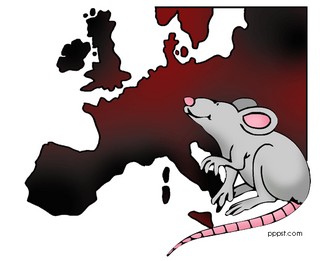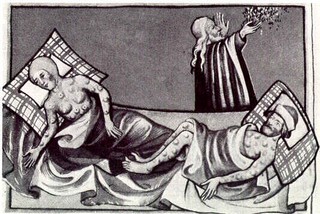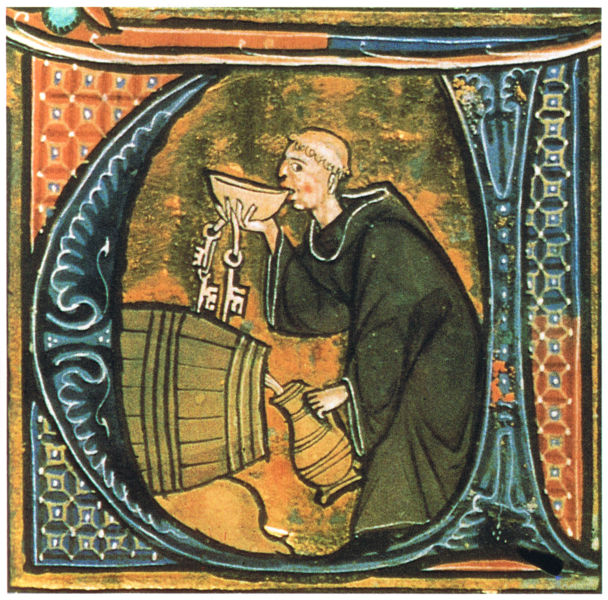Australia has been hit by serious flu viruses in the past and we have even had an outbreak of the Black Death (or to give it its medical name, the bubonic plague)! In 1900, 303 people in Sydney caught this disease and 103 died. By this stage in history people knew what caused the disease (unlike in 1348, when absurd and false theories abounded). A bounty was put on rats – sixpence a rat according to one Melbourne report. Poor and unemployed men became professional rat catchers. Here is a picture of them at work: 
************** This picture is copyright to the State of NSW and is kindly provided by the State Records Authority of NSW, who allow free dissemination of knowledge. I love public authorities with that kind of attitude. That pile in the middle is dead rats. Ewwwww….
Go to this link to view other fascinating and gruesome pictures, including closeups of rat heaps, quarantine areas being demolished, etc:
LINK: Purging Pestilence
And marvellous Melbourne (or Smellbourne as one wag of the period called it) also suffered from a case of the disease; read about this case in Camberwell.
LINK: Plague in Camberwell
 Clipart of rat kindly provided by http://www.phillipmartin.info/clipart/
Clipart of rat kindly provided by http://www.phillipmartin.info/clipart/
Anyway, back to the Black Death. One-third of the people of Europe died from this disease – and that was only counting the first time it struck them. In 1348 it struck a population without any immunity at all, a little like smallpox striking the native populations of South America and Australia.
The situation in medieval Europe made people particularly vulnerable to such a disease:
 Sanitation was very bad. People didn’t know about bacteria and as you walked along streets you had to step over faeces. Cities stank. Rats had plenty to feed on thanks to the butchers working in public and leaving piles of offal on the streets. Fleas were also commonplace. Peasants expected to have fleas, for instance.
Sanitation was very bad. People didn’t know about bacteria and as you walked along streets you had to step over faeces. Cities stank. Rats had plenty to feed on thanks to the butchers working in public and leaving piles of offal on the streets. Fleas were also commonplace. Peasants expected to have fleas, for instance.
 There was a great deal of poverty, malnutrition and poor health in a large percentage of the population. When the Black Death came it attacked a weakened population.The rate of mortality in untreated cases is reportedly around 40–60%. Presumably a healthy, well-fed person would have a better chance of survival than a poor, malnourished peasant – and Europe’s population was largely made up of poor, malnourished peasants.
There was a great deal of poverty, malnutrition and poor health in a large percentage of the population. When the Black Death came it attacked a weakened population.The rate of mortality in untreated cases is reportedly around 40–60%. Presumably a healthy, well-fed person would have a better chance of survival than a poor, malnourished peasant – and Europe’s population was largely made up of poor, malnourished peasants.

Watch pic kindly provided by http://desktoppub.about.com
|
According to a book from our school library, “The Death” by Amanda Braxton-Smith, some historians believe, based on evidence from digs in Ireland, that the average lifespan in the Middle Ages could have been about 25 years. This evidence suggests over half the women were dead by the age of 35 and one-third of the population had died before the age of 14. Of course, this may not be true of Europe as a whole but it gives an insight into medieval life (and death). |
To read about the mortality rate of the plague, go to the link below. You should be aware that just to complicate matters there were three kinds of plague, and the prognosis (likely medical outcome) for each was different.
LINK: Details of the plague’s mortality rate (with extra information about rats, fleas and so forth)
 Medical knowledge, at least amongst Christians, was woeful. While Islamic physicians were quite scientific in their methods, Christian doctors were ignorant of anatomy and other vital information. The Church was partly to blame. It controlled what doctors learned and it didn’t allow dissection of bodies. This meant that in one French medical school, for instance, there was only one practical anatomy lesson in two years. An abdomen was opened and looked at; that was it. The prescriptions of doctors at the time of the plague were dangerous rather than therapeutic. (Read the examples further down.)
Medical knowledge, at least amongst Christians, was woeful. While Islamic physicians were quite scientific in their methods, Christian doctors were ignorant of anatomy and other vital information. The Church was partly to blame. It controlled what doctors learned and it didn’t allow dissection of bodies. This meant that in one French medical school, for instance, there was only one practical anatomy lesson in two years. An abdomen was opened and looked at; that was it. The prescriptions of doctors at the time of the plague were dangerous rather than therapeutic. (Read the examples further down.)
 Another problem was that the Church viewed disease as a punishment for sin. Some people believed that if you had leprosy it had been brought on by too much lust. In such an environment of blame and ignorance, you can imagine that careful scientific examination and rigorous observation of symptoms would be uncommon.
Another problem was that the Church viewed disease as a punishment for sin. Some people believed that if you had leprosy it had been brought on by too much lust. In such an environment of blame and ignorance, you can imagine that careful scientific examination and rigorous observation of symptoms would be uncommon.
 If doctors were ignorant, then the rest of the population, mostly illiterate, was even more so. It was a very superstitious period and wild rumours and prejudices rapidly took hold. This meant that instead of doing useful things like quarantining people, cleaning up filthy areas and burning plague-infested areas (all done by the Sydney administration in 1900), medieval people often reacted by blaming the innocent.
If doctors were ignorant, then the rest of the population, mostly illiterate, was even more so. It was a very superstitious period and wild rumours and prejudices rapidly took hold. This meant that instead of doing useful things like quarantining people, cleaning up filthy areas and burning plague-infested areas (all done by the Sydney administration in 1900), medieval people often reacted by blaming the innocent.

From Wikipedia Commons, originally from the Jewish Encyclopedia, 1901–1906, and now in the Public Domain; picture titled, “French Jews of the Middle Ages”
The Jews were one group who were accused of poisoning wells and infecting people with plague. Historians have suggested this might have something to do with the fact that less Jews died from the plague. The Jewish holy book (Torah) gives advice on basic hygiene to stop the spread of diseases. This meant many Jews refused to use the unhygienic wells (located near the town sewage pit), choosing instead to drink from fresh water sources. It is likely this led to our led our superstitious Medieval friends blaming the Jews for the plague. Jews were massacred, tortured and even burned alive. It was horrific. Some writers believe it was the worst persecution of the Jews before the Nazis in the 20th century showed atrocious cruelty on an even greater scale and with all the technology of the modern world behind them. This type of massacre of a specific minority (in most cases used to refer to the killing of Jews) is called a pogrom.

|
“Woe is me of the shilling in the arm-pit; it is seething, terrible, wherever it may come, a head that gives pain and causes a loud cry, a burden carried under the arms, a painful angry knob…” – Jeuan Gethin (died 1349) – quoted in “The Death” by Amanda Braxton-Smith. |
Picture in Public Domain from Wikimedia Commons. Check the buboes. The man in the background may be holding a bunch of herbs, which were erroneously thought to help ward off disease by filling the air or at least the person’s breathing space with healthy odours.
Here are some other crazy medieval ideas showing what people believed could cause and cure the plague:
Things that some people believed caused the plague (added information from Ms Taylor):
 The alignment of Mars, Jupiter and Saturn, which were close together on 24 March, 1345. In Medieval Europe great importance was placed on astrology and the movements of the stars and planets. They also used this technique when planning and performing operations (apprentice doctors had to learn which days were “unlucky” for performing surgery).
The alignment of Mars, Jupiter and Saturn, which were close together on 24 March, 1345. In Medieval Europe great importance was placed on astrology and the movements of the stars and planets. They also used this technique when planning and performing operations (apprentice doctors had to learn which days were “unlucky” for performing surgery).
 Greedy traders and priests. This probably came from the belief that the plague was a punishment from God for all the sins of humanity.
Greedy traders and priests. This probably came from the belief that the plague was a punishment from God for all the sins of humanity.
 Children who disobey their parents. This might have just been said to scare children, but it is also possible that people believed this. Many young children died because they weren’t strong enough to fight off the disease.
Children who disobey their parents. This might have just been said to scare children, but it is also possible that people believed this. Many young children died because they weren’t strong enough to fight off the disease.
 Earthquakes, floods, tidal waves and unusual weather (classic “God’s wrath” belief)
Earthquakes, floods, tidal waves and unusual weather (classic “God’s wrath” belief)
 Blockages and bad digestion in the body – more brilliant Medieval medicine at work.
Blockages and bad digestion in the body – more brilliant Medieval medicine at work.
What some people believed would cure the plague:
 People should seclude themselves from others and stay away from the infected air. (This wasn’t a bad idea, but it would have been difficult to put into practice. You can’t stay home for ever.)
People should seclude themselves from others and stay away from the infected air. (This wasn’t a bad idea, but it would have been difficult to put into practice. You can’t stay home for ever.)
 People should burn scented woods to purify the bad air and fill their homes with pleasant-smelling plants and flowers. (This is what happened to the pope, who sat isolated in a room with two fires all summer; he survived but one third of his staff weren’t so fortunate.)
People should burn scented woods to purify the bad air and fill their homes with pleasant-smelling plants and flowers. (This is what happened to the pope, who sat isolated in a room with two fires all summer; he survived but one third of his staff weren’t so fortunate.)
 Tranquility! Try to keep a tranquil mind while the world around you is ending.
Tranquility! Try to keep a tranquil mind while the world around you is ending.
 Open and cauterize the buboes (burn them with a hot iron or caustic agent) and apply some substance to draw out the poison. One recipe for such a substance was a plaster made from gum resin, roots of white lilies and dried human excrement. Yurghh…
Open and cauterize the buboes (burn them with a hot iron or caustic agent) and apply some substance to draw out the poison. One recipe for such a substance was a plaster made from gum resin, roots of white lilies and dried human excrement. Yurghh…
 Take soothing potions. Some of the recipes don’t sound very soothing though! Here was one: take an ounce (28 grams) of gold, 11 ounces of quicksilver, dissolve and let the quicksilver escape; add 47 ounces of water and drink. Somehow I doubt that many people would have had the wealth or resources to make this potion – which is just as well.
Take soothing potions. Some of the recipes don’t sound very soothing though! Here was one: take an ounce (28 grams) of gold, 11 ounces of quicksilver, dissolve and let the quicksilver escape; add 47 ounces of water and drink. Somehow I doubt that many people would have had the wealth or resources to make this potion – which is just as well.
 Some doctors suggested people should bathe in urine. Others warned against bathing as it would open the pores to let in the disease.
Some doctors suggested people should bathe in urine. Others warned against bathing as it would open the pores to let in the disease.
 Some people thought the plague could be avoided by sniffing bad smells such as latrines (hole in the ground – used as a toilet). Following this theory, that the two bad smells counteract one another, some people put dead animals in their houses.
Some people thought the plague could be avoided by sniffing bad smells such as latrines (hole in the ground – used as a toilet). Following this theory, that the two bad smells counteract one another, some people put dead animals in their houses.
*************
The following writings are primary sources compiled in the text book: “Discovering the Medieval World” which was written by J. Eshuys, V. Guest and P. Phelan. You can find this book in the library and these sources on page 166.
**”The swellings should be softened with figs and cooked onions mixed with yeast and butter” -Guy de Chauliac (a famous Medieval doctor who apparently tried this method after becoming ill and after 6 weeks was cured, “by God’s grace”)
**”Toads should be thoroughly dried in the sun. They should be placed on the swellings. The toad will draw out the poison of the plague into its own body” -Another Medieval doctor’s advice.
**“Some people formed small seperate communities. They shut themselves up in houses where there were no sick, eating the finest food and drinking the best wine, avoiding all excess and pasing the time in music and such pleasures.”
**”Others thought the sure cure for the plague was to drink and be merry, to go about singing and amusing themselves, satisfying every appetite they could.”
-This last comment shows how the plague caused many people to give up all hope. Many people thought the plague was a punishment from God for their sins. However, because so many priests died and there seemed no end to the plague (remember everyone they knew was dying!) many people abandoned religion and lawful activity and spent their last days sinning; eating too much, swearing, gambling and drinking to excess!

This cheeky monk image can be found here: Wikipedia Commons
What would you do if you were living in Medieval Europe and so many people around you were dying from a disease that no one could cure?
Miss Taylor says: I personally like the sound of eating all the finest foods in a house with no plague victims, but I think I would get sick of being isolated, especially if someone from my family was sick and wasn’t allowed in!
Leave a comment:
What do you think you would do if your city were suddenly besieged by a killer disease? Would you party (because tomorrow you could die), would you hole up in your house, would you go and live in the country or would you meditate twice a day whilst thinking pure thoughts? I’m sure you have many ideas that are not amongst my suggestions! Write a comment about what you might do. Remember that you live in medieval Europe, so your answer must be in keeping with that fact.
Frenetic typing student pic below kindly provided by www.animatedclipart.net
After leaving your comment, test your black death knowledge at this great quiz site:
1) First use the flash cards to make sure you are familiar with the terminology (try to learn the spelling of the tricky words, you will need it later!)
2) If you want a challenge: uncheck the box that says “both sides” in the top right hand corner. Clicking on the flashcard will reveal the answer!
3) Now you are free to try the buttons below. Try “test” for a fun test that involves multiple choice and true/false answers. Space race is a brilliant race against time game. Who can get the highest score in the class?
The link to the site can be found here: http://quizlet.com/2280769/black-death-flash-cards/
 Animated book kindly provided by www.animatedclipart.net
Animated book kindly provided by www.animatedclipart.net


i would just party and live life happily as it was almost certain you would die. if you didnt, someone else close to you would die. seems like a harsh life.
I would go to the country side, or maybe somewhere in the mountains; I would hunt or forrage for food. I would make clothes out of the animals I hunted’s hides and just become a hermit basically. better than dying of the plague, isnt it?
Matt
Well, apparently, we can have modern day knowlege, but medievel technology, so we can’t just jump on a train and go to America.
Because of that, the best way to go about it would be to stay hygienic. wash your hands every day, have a shower, wash your clothes. Of course, that won’t do a thing if you’re bitten by a rat, so…
…move to the country! problem solved. take all your family (if they’re not contaminated) and move to the country (let’s assume were moderately wealthy here.) find a place with fresh water; a stream perhaps.
As an extreme mesure, you could shave your hair to stop the fleas, and grow some of your own food. The stuff I mentioned up the top about hygiene would use a hell of a lot of water, too much to use in modern Australia. That’s why I suggested a stream; lots of water, and all healthy, clean, and black-death-proof.
I would try to sneak out of the city and try to find another place in Europe that was uninfected
i would stay away and not touch anyone/anything that is abnormal. if they are acting funny or have lumps or rashes i would not contact them. i would them immigrate to another country.
Dewansh
I would lock all the doors and windows of my house and start frantically cleaning everything. :0
I would attempt to avoid it and if i couldn’t i would live each moment like my last
I would do everything I would have wanted to do for I could get sick at a random time.
I would run to a different city, after taking the antidote so that I don’t spread the disease. I would contact a doctor and ask him for advice, but check to see if it was logical before I did something ridiculous. I would take all medical precautions before I left, and also half way through my journey to the next city to be sure.
I would grab all things precious to me (e.g: medicine, good food, some money, etc, etc…) and shut myself in my house. I would then clean everything, take at least three baths a day and enjoy life, because I might catch the plague and die some time sooner.